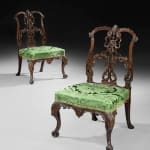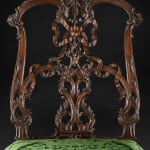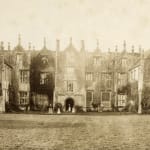Open a larger version of the following image in a popup:


Barrington Court, Somerset, UK, photographed in the 1890s
A PAIR OF GEORGE II MAHOGANY RIBBON-BACK CHAIRS
ENGLISH, CIRCA 1755 - 56
H: 100.3cm (39.5")
W: 74.3cm (29.25")
D: 64.8cm (25.5")
W: 74.3cm (29.25")
D: 64.8cm (25.5")
Further images
Provenance
Part of the set of eight most likely acquired by Thomas Harvard for Barrington Court, near Ilminster, Somerset, circa 1756
Removed to Dillington House, near Ilminster, Somerset, in the early nineteenth century.
With R.L. Harrington, Ltd.
With Hotspur Ltd., London
Private Collection, London
Sold Christie's, London, 6 July 2023, lot 53, GBP 107,100
Private Collection: West Coast, USA
Publications
A. Coleridge, Chippendale Furniture (London, 1968), figs. 173-5Nicholas Carew, `Montacute House, Somerset', Connoisseur Year Book (1952), p. 17, No. IX, the set of eight chairs in the dining room
G. Wills, English Furniture, 1760-1900 (London, 1971), p.18
N. Goodison and R. Kern, Hotspur: Eighty Years of Antique Dealing (London, 2004), pp. 136-7, fig. 8
J. L. Milne, Caves of Ice, Diaries: 1946 & 1947, pp. 127-8
L. Wood, ‘Tied Up In Knots: Three Centuries of the Ribbon-Back Chair,’ Furniture History (2015), vol. 51, pp. 241–70
The ‘ribbon-back’ chair, named for the elaborate ribbon motifs incorporated into the carving on the chair backs, is one of the most recognised designs published in Chippendale’s pattern book, The Gentleman and Cabinet-Maker’s Director and is often viewed as synonymous with his style. The present chairs are derived from the right-hand pattern on Plate XVI. Closely related designs for chairs also featured on the trade cards of Chippendale's contemporaries William Henshaw, cabinet-maker and upholsterer and subscriber to Chippendale's Director, St Paul's Church Yard (1754 - 73) and William Jellicoe, upholsterer, appraiser and undertaker of Fleet Street (1760 - 81). Lucy Wood states that either Henshaw or Jellicoe could be considered likely candidates to have supplied the chairs (L. Wood, op. cit., pp. 241-3).
The present chairs are originally from a suite of eight chairs traced to Dillington House in Somerset. As Lucy Wood discusses in her article, Dillington House was acquired by the Hanning family in the early nineteenth century and ‘Gothicized’ by John Lee Lee (Hanning) (1802-74) in the 1830s. Thus, Wood’s research indicates the suite was most likely acquired by Thomas Harvard, John Lee Lee’s great-great-grandfather, to furnish his nearby Barrington Court, an Elizabethan manor he purchased in 1756. Barrington Court remained in the Hanning family but because they began living primarily at Dillington House by the early nineteenth century, Barrington was eventually rented out and ultimately sold before 1858 (A. Baggs & R. Bush, A History of the County of Somerset, v. 4 (London, 1978), pp. 113-121). Therefore, the suite of ribbon-back chairs were moved to Dillington prior to the sale. Indeed, inventories taken at Dillington in 1874 and 1882 record ‘6 Carved Mahogany Antique Chairs’ in the Drawing Room, and ‘2 Carved Mahogany Chairs’ in the Dining Room which likely constitute the suite of eight.
The suite remained at Dillington House and passed by inheritance to Elizabeth Cameron (nee Vaughn-Lee), who lent them to the National Trust at Montacute House from 1948-1979, from which an old loan inventory card records them as a set of eight. Hotspur Ltd. later acquired six from the suite and sold them in pairs. One pair entered the collection of S. Jon Gerstenfeld, Washington D. C. (sold Christie’s London, 7 July 1988, lot 77, GBP £82,500) and was subsequently in the collection of Ann and Gordon Getty, sold Christie’s New York, 23 October 2022, lot 554 (USD $214,200). A second pair is now in the Indianapolis Museum of Arts [81.375, 81.376]. The third is that offered here.
The present chairs are originally from a suite of eight chairs traced to Dillington House in Somerset. As Lucy Wood discusses in her article, Dillington House was acquired by the Hanning family in the early nineteenth century and ‘Gothicized’ by John Lee Lee (Hanning) (1802-74) in the 1830s. Thus, Wood’s research indicates the suite was most likely acquired by Thomas Harvard, John Lee Lee’s great-great-grandfather, to furnish his nearby Barrington Court, an Elizabethan manor he purchased in 1756. Barrington Court remained in the Hanning family but because they began living primarily at Dillington House by the early nineteenth century, Barrington was eventually rented out and ultimately sold before 1858 (A. Baggs & R. Bush, A History of the County of Somerset, v. 4 (London, 1978), pp. 113-121). Therefore, the suite of ribbon-back chairs were moved to Dillington prior to the sale. Indeed, inventories taken at Dillington in 1874 and 1882 record ‘6 Carved Mahogany Antique Chairs’ in the Drawing Room, and ‘2 Carved Mahogany Chairs’ in the Dining Room which likely constitute the suite of eight.
The suite remained at Dillington House and passed by inheritance to Elizabeth Cameron (nee Vaughn-Lee), who lent them to the National Trust at Montacute House from 1948-1979, from which an old loan inventory card records them as a set of eight. Hotspur Ltd. later acquired six from the suite and sold them in pairs. One pair entered the collection of S. Jon Gerstenfeld, Washington D. C. (sold Christie’s London, 7 July 1988, lot 77, GBP £82,500) and was subsequently in the collection of Ann and Gordon Getty, sold Christie’s New York, 23 October 2022, lot 554 (USD $214,200). A second pair is now in the Indianapolis Museum of Arts [81.375, 81.376]. The third is that offered here.
1
of
13






